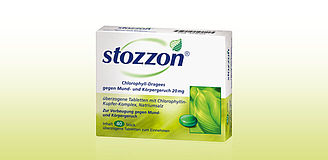
Healthy teeth and gums reduce the risk of developing bad breath
Poor oral hygiene due to teeth not being properly cleaned and not cleaning the tongue is the most common cause of bad breath. In particular, food residue in the difficult-to-clean interdental spaces and plaque provide bacteria with food, the decomposition of which leads to the development of bad breath. In addition, unhealthy teeth and gums, if they are affected by periodontal disease for example, cause bad breath.
The oral cavity provides a living environment for the countless microorganisms that settle there. The microorganisms live there in stable, ecological, and, for us, healthy, harmony. With optimal tooth and gum hygiene we have a direct influence on our oral flora, in that we keep the bacteria that cause bad breath in check.
Tooth and gum disease – Causes of bad breath
Defective fillings and bridges are singled out as local causes for bad breath. But, illnesses such as
- dental caries (disease affecting the tooth structure, dental enamel and dentin),
- periodontitis (inflammation of the periodontium),
- stomatitis (disease of the mucous membrane in the oral cavity)
- and gingivitis (inflammation of the gums)
also commonly cause bad breath. The cause for this lies in the cavities in the gums caused by the illness, the so-called gingival pockets and interdental spaces. The residual food is collected here and, along with it, so are countless microorganisms.

Maintaining the bacterial balance in the mouth
The dominant bacteria are these anaerobic bacteria, the so-called putrefactive bacteria. They don’t need oxygen to survive and so can live and multiply deep within gingival pockets without any problems. Normally, these bacteria are stopped from multiplying excessively by their opponents, the aerobic bacteria. However, as the aerobic bacteria need oxygen to survive, in certain affected areas of the oral cavity they are unable to do this task, sometimes completely or sometimes just not sufficiently. This leads to an imbalance of the normally prevailingly healthy, ecological balance in the “Oral cavity biotope” and in the oral flora.
Putrefactive bacteria prefer to feed off protein-rich foods. Their metabolic waste is the plaque and unpleasant smelling sulphur compounds. If they are in the majority because of a lack of oral hygiene and oral health then their waste gases also take over our breath: So we end up with bad breath.
Warnings of the oral flora system: Bleeding gums
One of the first indications of a disturbed oral climate is bleeding gums. To understand why bleeding gums should be taken seriously, you must be aware that a mucous membrane which is bleeding lightly is more at risk of being affected by germs and diseases. Germs can enter the body through small wounds or sores in the mouth and cause damage there. In addition, experts warn that people who have periodontitis, independent of any other risk factors, have at least double the risk of suffering from a heart attack or stroke.
If you regularly notice bleeding when brushing your teeth or eating, you should urgently contact your dentist.
As a first step, you should exhaust absolutely all possibilities for optimum mouth and teeth cleaning. Also read our topic “Optimal dental hygiene, how to do it properly”
Most of the time, the causes of bad breath are to do with the mouth. However, there can also be other causes such as a disturbance in the gastrointestinal area, for example.








